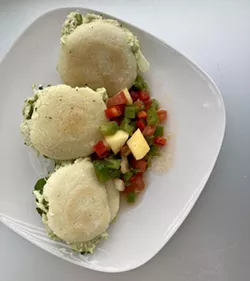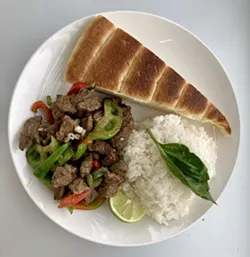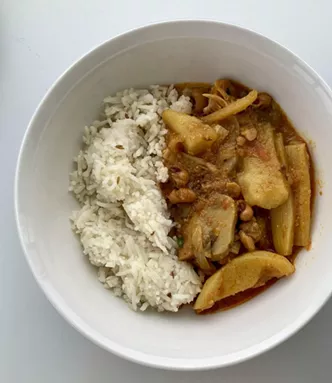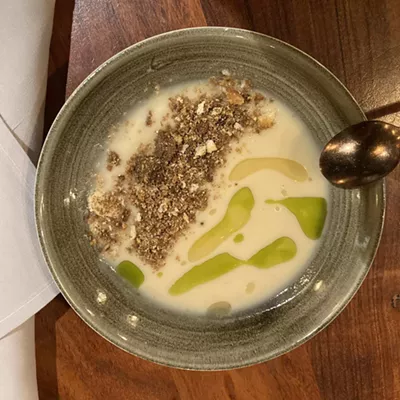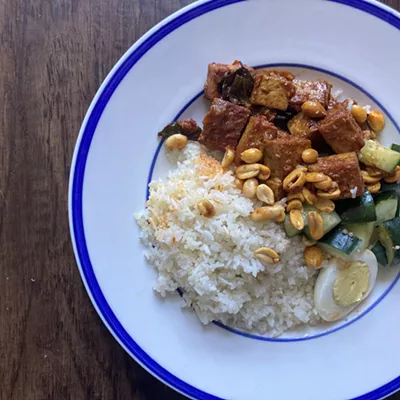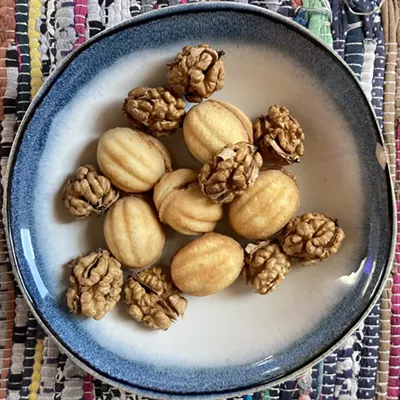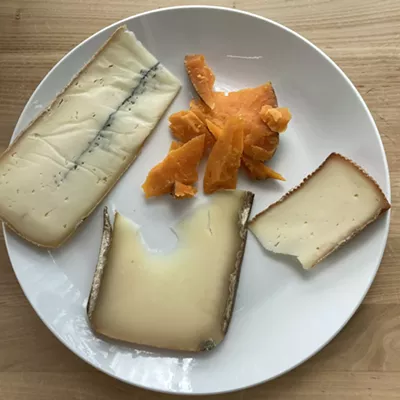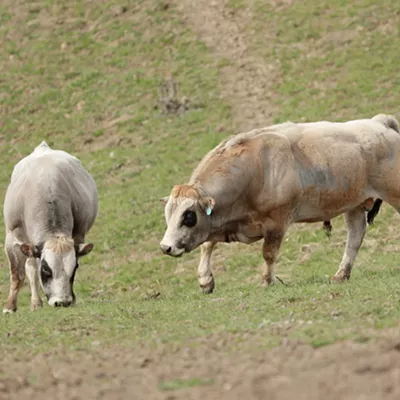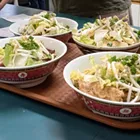Around the World in 80 Plates: Arepas from Venezuela, Derek Tibs from Eritrea, Tarkari from Bhutan
[
{
"name": "Broadstreet - Instory",
"component": "25846487",
"insertPoint": "4",
"requiredCountToDisplay": "4"
},{
"name": "Broadstreet - Empower Local",
"component": "27852456",
"insertPoint": "8",
"requiredCountToDisplay": "8"
},{
"name": "Broadstreet - Instory",
"component": "25846487",
"insertPoint": "12",
"requiredCountToDisplay": "12"
},{
"name": "Broadstreet - Instory - 728x90 / 970x250",
"component": "27852677",
"insertPoint": "18",
"requiredCountToDisplay": "18"
},{
"name": "Broadstreet - Instory",
"component": "25846487",
"insertPoint": "5th",
"startingPoint": "23",
"requiredCountToDisplay": "24",
"maxInsertions": 100
}
]
This is an installment of the Inlander's yearlong project "Around the World in 80 Plates," a quest to find 80 foods and drinks in Spokane representing 80 different places. Read the introduction to the project here.
Count of dishes/places: 15
We are smack dab in the middle of Inlander Restaurant Week, and I think I'm toeing the line between celebration and gluttony. Ironically, Lent started a couple weeks ago, a season of the Christian church traditionally marked by fasting. But instead of eating in mindfulness and moderation, I've crammed five restaurants into four days, or 15 courses in about seven hours. It's kinda like a marathon, but only for my stomach. Just to keep my calorie intake reasonable, I try to eat less during the day so I can feast at dinner.
It's an interesting rhythm, not one that I want to keep forever but one that I can probably learn from. It's nice to be reminded that through days and weeks and years, life switchbacks between seasons of fasting and feasting. And for these 10 days, my life (or my job) is telling me it's time to FEAST.
And what could be more perfect than feasting with Feast World Kitchen? The nonprofit kitchen usually hosts a different immigrant, refugee or international chef each day. But for Restaurant Week, they're hosting nine of their regular chefs every day — one for each course on their menu. Talk about a lot of cooks in the kitchen.
In one meal, you can choose an appetizer from Syria, Sudan or Venezuela, then an entree from Malaysia, Bhutan or Eritrea, and finish it off with a dessert from Iraq, Mexico or Indonesia. If I could eat even more, I could knock out this entire Around the World project a whole lot faster. But the great thing is that these chefs are often featured during Feast's weekly rotations. So if you didn't get to stop in during Inlander Restaurant Week, don't worry. Just keep an eye on Feast during ordinary weeks and look for the foods you want to try. You'll probably get to pace yourself a little bit more, which definitely isn't a bad thing.
But in the spirit of feasting at Feast, I put on my stretchy pants and got three plates at once, each with unique heritages and flavors. As the chefs were busy in the back cooking and trying not to step on toes, I did a little research on each dish on my own. I needed a bit of a break between bites, anyway.
CHEF RICARDO'S REINA PEPIADA AREPAS FROM VENEZUELA
There is a friendly, or not so friendly, controversy over whether Colombians or Venezuelans created the arepa, a thick pocket of fried cornmeal that's stuffed with meat, cheese, beans or something sweet. Colombian arepas are usually sweeter and simpler, topped with just butter and salty cheese. Venezuelans, on the other hand, are maximalists, stuffing anything and everything into the griddle cake.
The truth is that the arepa pre-dates European colonization. Early arepas were eaten and enjoyed by Indigenous people who lived across what is now Colombia, Venezuela, Ecuador and Panama. Spaniards introduced cheese and nation-states later on. But the arepa, in all its forms, has stood the test of time.
No matter what, Chef Ricardo's arepas at Feast are undeniably Venezuelan. Overstuffed with an herby, refreshing avocado-chicken salad, they pay homage to a famous Venezuelan recipe. Reina pepiada arepas were created in 1955 by the Alvarez family, owners of a famous arepa stand in Caracas. They created a brand new filling to honor Venezuelan Susana Duijm, the first Latin American woman to win Miss Universe.
Reina pepiada literally means "curvy queen," a title thought fitting of the most beautiful woman in the world. It's a compliment that lost some luster during the Twiggy-riddled 1960s, but it's finally coming back into vogue. I, for one, couldn't be more thrilled — for me and for these arepas.
They're wonderfully round and bite sized, though the avocado-chicken salad overfloweth. The mango pico de gallo adds fresh crunch that's both sour and sweet. Apparently, reina pepiada arepas are some of the most common arepas in Venezuela, with good reason. They're gorgeous to look at, filling yet refreshing, and definitely make me feel like a queen.
CHEFS KIDANE AND BESRAT'S DEREK TIBS STIR FRY
Meat is an important part of an Eritrean diet, not for its prevalence, but for its scarcity.
There are 180 days of obligatory fasting for those in the Eritrean Orthodox Tewahdo Church, and 250 days total for especially devout groups like monks and nuns. The best estimates guess that about half of Eritrea is Orthodox Christian, and the other half is Muslim. Muslims also practice fasting, especially during the 30 days of Ramadan, the ninth month of the Islamic calendar. This year, Ramadan and Lent, the longest stretch of fasting for Christians, overlap for most of March.
Fasting often brings deeper meaning to feasting. Abstaining from meat for a month, or up to half the year, makes eating meat more celebratory and special. If you're going to eat meat, it better be good.
Enter derek tibs, a stir fry popular in Ethiopia and Eritrea for its spiced beef, lamb or goat. The meat is seared in a pan with spices and a little butter or oil, resulting in a crispy, drier meat bursting with flavor from the onions, bell peppers and East African spices. It looks simple, but boasts deceptively complex flavors.
In some places, derek tibs is served in earthenware bowls with hot coals in the bottom, so the bottom pieces get especially crunchy. Chefs Kidane and Besrat at Feast know the secret to panfrying the meat until it's cooked through and satisfying to chew but not tough or dry on the inside.
While Ethiopians serve derek tibs with injera, a thin, sour, rolled up flatbread made from teff, these Eritrean chefs serve their dish with traditional himbasha bread. Himbasha, also called ambasha, couldn't be more different than injera. It's much more like a cake than a flatbread, and it's most often reserved for Christmas or other special occasions. It's slightly sweet, often flavored with crushed cardamom, and incredibly spongey, almost the density of a Japanese mochi cake. It cushions the chewy meat and absorbs the aromatics while adding its own light, fruity essences.
If I'm going to feast instead of fast, this was the perfect dish — celebratory and special, full of deep meaning and flavors, and something to keep me fed and energized for whatever lean days lay ahead.
CHEF MITRA'S TARKARI FROM NEPAL
Tarkari just means "vegetable" in Urdu, but it can refer to any number of vegetable dishes from India, Bangladesh, Pakistan and Nepal.
Strict vegetarianism isn't the norm in Nepal, but it's very common in the neighboring country Bhutan, which is majority Buddhist. Though not all Buddhists avoid meat, there are always plenty of options for vegetarians in Bhutan. This Nepali-style tarkari, a vegan curry, transfers seamlessly crosses the border into Bhutan, where chef Mitra grew up.
Chef Mitra chooses potatoes, jackfruit, mushrooms, bamboo shoots and black-eyed peas for her curry, which is deep, permanent yellow from the turmeric. The veggies are soft and velvety, coated in spice — the kind of spice that elevates flavor instead of covering it up. The rice is flavored, too, with small seeds that look like ajwain or fennel seeds. Ajwain seeds are also called carom seeds, and are considered by some traditional medicines to help ease cold symptoms, relieve indigestion and bloating, and protect against other minor, squeaky, smelly inconveniences of eating a lot of veggies and beans.
With expert hands and a dialed in palate, Mitra transforms humble vegetables into a veritable feast. Without meat, dairy, or eggs, the curry is rich and complex, with different textures and a hearty kick of spice at the end. If you're abstaining from animal products for a day or a lifetime, this dish doesn't make you feel like you're missing out on anything.
Spring means fasting for some and feasting for others, or maybe a little of both for all of us. I, for one, am actually looking forward to the end of this feast season. It's delicious, but it's overwhelming when it's constant. I need some lean time to think, refresh and be grateful. ♦
Have an idea for what I should eat next? Wanna make me a favorite dish from your hometown, or share a favorite celebration food? Send 80 Plates tips and ideas to elizab@inlander.com.
Count of dishes/places: 15
We are smack dab in the middle of Inlander Restaurant Week, and I think I'm toeing the line between celebration and gluttony. Ironically, Lent started a couple weeks ago, a season of the Christian church traditionally marked by fasting. But instead of eating in mindfulness and moderation, I've crammed five restaurants into four days, or 15 courses in about seven hours. It's kinda like a marathon, but only for my stomach. Just to keep my calorie intake reasonable, I try to eat less during the day so I can feast at dinner.
It's an interesting rhythm, not one that I want to keep forever but one that I can probably learn from. It's nice to be reminded that through days and weeks and years, life switchbacks between seasons of fasting and feasting. And for these 10 days, my life (or my job) is telling me it's time to FEAST.
And what could be more perfect than feasting with Feast World Kitchen? The nonprofit kitchen usually hosts a different immigrant, refugee or international chef each day. But for Restaurant Week, they're hosting nine of their regular chefs every day — one for each course on their menu. Talk about a lot of cooks in the kitchen.
In one meal, you can choose an appetizer from Syria, Sudan or Venezuela, then an entree from Malaysia, Bhutan or Eritrea, and finish it off with a dessert from Iraq, Mexico or Indonesia. If I could eat even more, I could knock out this entire Around the World project a whole lot faster. But the great thing is that these chefs are often featured during Feast's weekly rotations. So if you didn't get to stop in during Inlander Restaurant Week, don't worry. Just keep an eye on Feast during ordinary weeks and look for the foods you want to try. You'll probably get to pace yourself a little bit more, which definitely isn't a bad thing.
But in the spirit of feasting at Feast, I put on my stretchy pants and got three plates at once, each with unique heritages and flavors. As the chefs were busy in the back cooking and trying not to step on toes, I did a little research on each dish on my own. I needed a bit of a break between bites, anyway.
CHEF RICARDO'S REINA PEPIADA AREPAS FROM VENEZUELA
There is a friendly, or not so friendly, controversy over whether Colombians or Venezuelans created the arepa, a thick pocket of fried cornmeal that's stuffed with meat, cheese, beans or something sweet. Colombian arepas are usually sweeter and simpler, topped with just butter and salty cheese. Venezuelans, on the other hand, are maximalists, stuffing anything and everything into the griddle cake.
The truth is that the arepa pre-dates European colonization. Early arepas were eaten and enjoyed by Indigenous people who lived across what is now Colombia, Venezuela, Ecuador and Panama. Spaniards introduced cheese and nation-states later on. But the arepa, in all its forms, has stood the test of time.
No matter what, Chef Ricardo's arepas at Feast are undeniably Venezuelan. Overstuffed with an herby, refreshing avocado-chicken salad, they pay homage to a famous Venezuelan recipe. Reina pepiada arepas were created in 1955 by the Alvarez family, owners of a famous arepa stand in Caracas. They created a brand new filling to honor Venezuelan Susana Duijm, the first Latin American woman to win Miss Universe.
Reina pepiada literally means "curvy queen," a title thought fitting of the most beautiful woman in the world. It's a compliment that lost some luster during the Twiggy-riddled 1960s, but it's finally coming back into vogue. I, for one, couldn't be more thrilled — for me and for these arepas.
They're wonderfully round and bite sized, though the avocado-chicken salad overfloweth. The mango pico de gallo adds fresh crunch that's both sour and sweet. Apparently, reina pepiada arepas are some of the most common arepas in Venezuela, with good reason. They're gorgeous to look at, filling yet refreshing, and definitely make me feel like a queen.
CHEFS KIDANE AND BESRAT'S DEREK TIBS STIR FRY
Meat is an important part of an Eritrean diet, not for its prevalence, but for its scarcity.
There are 180 days of obligatory fasting for those in the Eritrean Orthodox Tewahdo Church, and 250 days total for especially devout groups like monks and nuns. The best estimates guess that about half of Eritrea is Orthodox Christian, and the other half is Muslim. Muslims also practice fasting, especially during the 30 days of Ramadan, the ninth month of the Islamic calendar. This year, Ramadan and Lent, the longest stretch of fasting for Christians, overlap for most of March.
Fasting often brings deeper meaning to feasting. Abstaining from meat for a month, or up to half the year, makes eating meat more celebratory and special. If you're going to eat meat, it better be good.
Enter derek tibs, a stir fry popular in Ethiopia and Eritrea for its spiced beef, lamb or goat. The meat is seared in a pan with spices and a little butter or oil, resulting in a crispy, drier meat bursting with flavor from the onions, bell peppers and East African spices. It looks simple, but boasts deceptively complex flavors.
In some places, derek tibs is served in earthenware bowls with hot coals in the bottom, so the bottom pieces get especially crunchy. Chefs Kidane and Besrat at Feast know the secret to panfrying the meat until it's cooked through and satisfying to chew but not tough or dry on the inside.
While Ethiopians serve derek tibs with injera, a thin, sour, rolled up flatbread made from teff, these Eritrean chefs serve their dish with traditional himbasha bread. Himbasha, also called ambasha, couldn't be more different than injera. It's much more like a cake than a flatbread, and it's most often reserved for Christmas or other special occasions. It's slightly sweet, often flavored with crushed cardamom, and incredibly spongey, almost the density of a Japanese mochi cake. It cushions the chewy meat and absorbs the aromatics while adding its own light, fruity essences.
If I'm going to feast instead of fast, this was the perfect dish — celebratory and special, full of deep meaning and flavors, and something to keep me fed and energized for whatever lean days lay ahead.
CHEF MITRA'S TARKARI FROM NEPAL
Tarkari just means "vegetable" in Urdu, but it can refer to any number of vegetable dishes from India, Bangladesh, Pakistan and Nepal.
Strict vegetarianism isn't the norm in Nepal, but it's very common in the neighboring country Bhutan, which is majority Buddhist. Though not all Buddhists avoid meat, there are always plenty of options for vegetarians in Bhutan. This Nepali-style tarkari, a vegan curry, transfers seamlessly crosses the border into Bhutan, where chef Mitra grew up.
Chef Mitra chooses potatoes, jackfruit, mushrooms, bamboo shoots and black-eyed peas for her curry, which is deep, permanent yellow from the turmeric. The veggies are soft and velvety, coated in spice — the kind of spice that elevates flavor instead of covering it up. The rice is flavored, too, with small seeds that look like ajwain or fennel seeds. Ajwain seeds are also called carom seeds, and are considered by some traditional medicines to help ease cold symptoms, relieve indigestion and bloating, and protect against other minor, squeaky, smelly inconveniences of eating a lot of veggies and beans.
With expert hands and a dialed in palate, Mitra transforms humble vegetables into a veritable feast. Without meat, dairy, or eggs, the curry is rich and complex, with different textures and a hearty kick of spice at the end. If you're abstaining from animal products for a day or a lifetime, this dish doesn't make you feel like you're missing out on anything.
Spring means fasting for some and feasting for others, or maybe a little of both for all of us. I, for one, am actually looking forward to the end of this feast season. It's delicious, but it's overwhelming when it's constant. I need some lean time to think, refresh and be grateful. ♦
Have an idea for what I should eat next? Wanna make me a favorite dish from your hometown, or share a favorite celebration food? Send 80 Plates tips and ideas to elizab@inlander.com.


